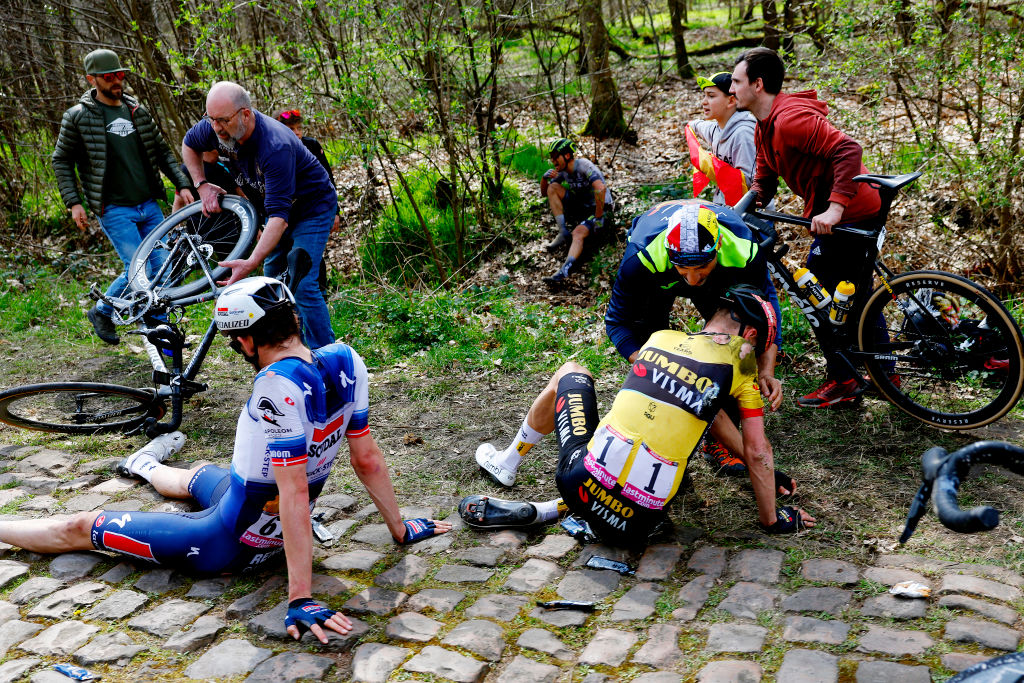
Several high-speed crashes and punctures on the cobbles of Paris-Roubaix have highlighted possible limitations of tubeless tyres in such extreme race conditions, with Vincenzo Nibali and Luke Rowe both speaking out about the tyre technology that has rapidly taken over in the professional peloton.
Derek Gee of Israel-Premier managed to stop his bike and avoided crashing after his front tyre punctured and came off the rim as he entered the Forest of Arenberg in the breakaway.
However, Fred Wright (Bahrain Victorious) wasn’t as fortunate. The Briton was racing at high speed in the Arenberg when his front tyre came off, with Wright crashing heavily. Other riders just behind him also went down, including 2022 Paris-Roubaix winner Dylan Van Baarle (Jumbo-Visma) and Kasper Asgreen (Soudal-QuickStep).
Both Gee and Wright appeared to be racing without the foam inserts or liners that some teams use and that could have helped ease the impact of the puncture and reduce the risk of crashing at high speed.
Neither Israel-Premier Tech nor Bahrain Victorious explained the reasons for their respective crashes after Paris-Roubaix. Israel-Premier Tech preferred not to comment when contacted with specific questions about their use of tubeless tyres and inserts while Bahrain Victorious had not replied at the time of publication.
Paris-Roubaix tech gallery: A deep dive into the tech from the men's race
‘The team doctor glued my face together’ - Dylan van Baarle on his Paris-Roubaix crash
Dylan van Baarle's shoulder fracture heads up Paris-Roubaix injury report
Peter Sagan crashes out of final Paris-Roubaix with concussion
As it happened: Paris-Roubaix 2023
Rowe shared his thoughts on the Paris-Roubaix crashes and his theory on the importance of tubeless inserts during the latest Watts Occuring podcast with teammate and fellow Welshman Geraint Thomas.
“I’ve got a bit of a theory of why there were so many crashes in Roubaix this year,” Rowe said.
“Everyone is riding tubeless now, whereas the year before it was probably 50-50 and the year before that everyone was riding tubulars. Now everyone is riding tubeless and if you puncture, you lose all pressure instantly.
“I think a lot of teams are not using liners but they’re putting their lives at risk. I really think it’s a big cause of so many crashes in Roubaix.
“I think, and I’m not going to say names or teams, but we (Ineos Grenadiers) ride with liners (inserts), so if you puncture, it keeps the shape of the type and a little bit of the pressure and you’re not straight on the rim.
“But it’s two or three watts faster without liners, so I think that people are that desperate that they’re racing without liners, but if they crash, and I’ve seen it happen so many times, the tyre just goes straight off the rim and you’ve got no chance.”
Rowe revealed that he opted to use foam inserts even for normal road races, to give him extra security in the case of a tyre blowout.
“They (Ineos Grenadiers) asked us about it and I said I’d rather get dropped because I can’t produce the extra two or three watts,” Rowe said.
Tubeless tyre and rim standards are guided by the European Tire Rim Technical Organization (E.T.R.T.O), who issue guidelines on engineering, dimensions, load and pressure characteristics. Their work helps avoid infinite types of tyres, shapes, and rim sizes and in turn, the risk of incompatible matching, potential crashes and injury. However, ETRTO-compliant tyres and rims all fall within a specified range of accepted real-world sizing, and it's possible that some combinations of wheel and tyre do create a greater chance of a tyre detaching from a rim.
Nibali was known for his bike handling skills during his long professional career and has a passion for bike mechanics. He posted his doubts about tubeless tyres on Instagram, with a screen grab image of Wright’s tyre coming off the rim as he crashed.
“Tubeless will never be as safe as tubulars. Make sure you know it!” Nibali wrote.
During his subsequent ‘Lo Squalo’ Twitch show with several other Italian riders, including Alberto Bettiol, Nibali confirmed his doubts about the use of tubeless at Paris-Roubaix.
“In a race like Paris-Roubaix, tubulars are still the safest choice because if you puncture, the tyre doesn’t come off. And so you reduce the risk of crashing,” he argued.
“With tubeless, if they don’t fit perfectly with the wheels or if the pressure is wrong, there is a risk of the tyre coming off and you’ve no chance of saving yourself, as we saw this year. There’s no comparison in terms of safety.
“I know that tubeless performs better, Colbrelli won his Roubaix on them with a slow puncture that sealed, but I think the tubeless technology can still be improved, especially to be used in extreme conditions like the pavé.”
Bettiol explained the performance benefits of tubeless tyres. However, his EF Education-EasyPost team work with Vittoria and use their green foam Air-Liner inserts.
“If a team isn’t using tubeless, it’s because they haven’t got hold of them,” Bettiol said.
“My team mechanics and team staff have explained how tubeless are much better. I can assure you the difference is huge, we’re talking about 10 watts at 45km/h and that’s the speed of Paris-Roubaix or the Tour of Flanders.”







